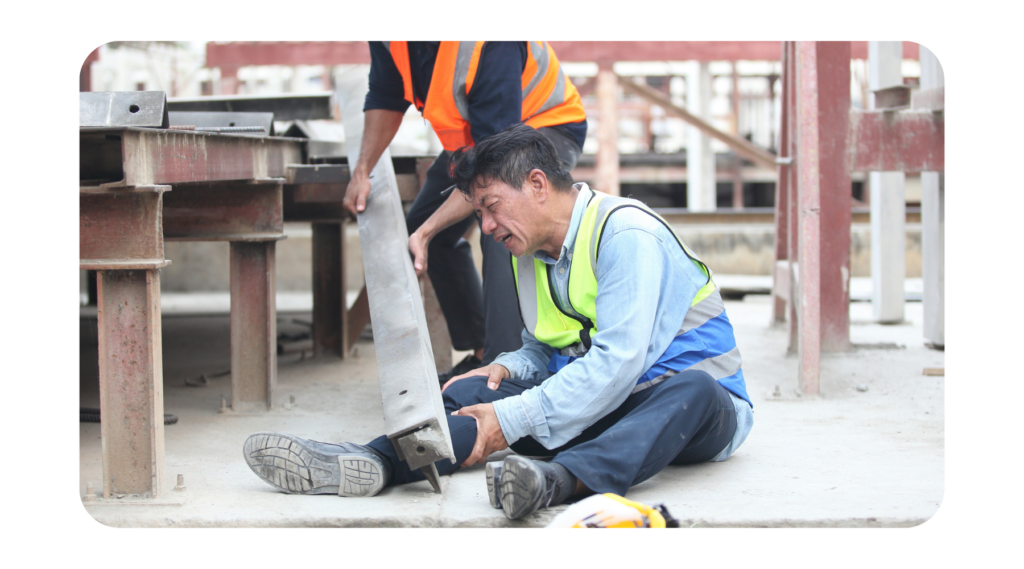Common Construction Site Accidents

Construction sites can be dangerous places given the equipment and heavy machinery required. According to the Bureau of Labor Statistics, Census of Fatal Occupational Injuries (CFOI) program, construction site injuries were the second leading cause of occupational worksite fatalities in 2020.
There are countless ways construction workers can be injured on site, but there are many common construction accidents that workers and others experience. Fall accidents due to the improper placement of construction materials and unsafe access to the workplace are among the most common construction accidents, followed by struck-by, electrocutions, and caught-in or -between – referred to as the “Fatal Four.” The “Fatal Four” accounts for more than half of all construction accidents.
If you’re a victim of any of these common construction accidents, our construction accident lawyers in Marin county can pursue compensation claims on your behalf to ensure quality of life after suffering injuries, whether catastrophic or otherwise.
- Falls – Largest Cause of Construction Accidents
- Electrocution and Struck By Object Accidents Each Cause Eight Percent of Deaths
- Fourth-Largest Cause of Death: Caught-In or -Between
- Catastrophic Injuries and Their Long-Term Effects
- What is Covered in Compensation?
- How Can a Construction Accident Lawyer Help?
Falls – Largest Cause of Common Construction Accidents
It is the responsibility of construction companies to provide safety equipment like catwalks, ladders, harnesses, and secure scaffolding to protect their construction workers and prevent workplace injuries. Occupational and Safety Health Administration (OSHA) standards require fall protection in certain circumstances. These companies must not only provide safe conditions but also perform regular inspections and maintenance and educate their employees on fall prevention measures. When quality safety measures are not implemented, accidents are much more likely.
According to OSHA, fall accidents, the largest of all common construction accidents, led to 37% of construction deaths in 2021. The causes of falls vary from falling off ladders, scaffolding, or from a height to falling due to spills, tripping over equipment, or leaving elevator shafts unguarded.
Electrocution and Struck By Object Accidents Each Cause Eight Percent of Deaths

Construction workers may encounter exposed wiring and wet conditions; poorly maintained power tools and cords; energized conductors or circuit parts; contact with overheard powerlines; and even lightning strikes. All of these dangerous conditions and situations may lead to electrocution. OSHA provides electrical standards to diminish the risk of electrocution accidents.
In 2021, electrocution led to eight percent of construction deaths. Contact with live wires is the most common cause of electrocution in construction. The greater the electric current a worker contacts, the more severe the injury. Electricians, power line workers, mechanics, HVAC professionals, roofers, and laborers frequently work with or near live wiring, putting them at risk for accidents and injuries.
Another eight percent of construction workers in 2021 were fatally wounded when they were struck by objects that were falling, swinging, rolling, or misplaced. Objects may fall due to loose or shifting materials, rigging failure, equipment malfunctions, or vehicle and equipment strikes. Workers may experience flying nuts and bolts; falling suspended loads; dropped tools; broken high-pressure hoses and lines; or falling lumber, pipes, or scaffolding. Another common cause of injury and death is cranes, which can collapse, overturn, or hit people.
Injuries vary depending on the size of the object and how fast it is traveling. Construction workers must be aware of their surroundings and can follow these tips and utilize these resources to protect themselves.
The Fourth Largest Cause of Death When It Comes To The Most Common Construction Accidents Are Caught-In or -Between
Employees have been caught in or between devices, machines, tools, and trenches, leading to five percent of construction deaths in 2021. “Caught in-between” accidents are characterized as incidents of being crushed, squeezed, caught, or pinched between two objects, as well as when a worker is buried. Scenarios include being caught in or between collapsing structures or moving or rotating equipment and trapped in a trench, masonry wall, or excavation collapse.
These situations arise due to improperly maintained equipment; walls not being braced well; scaffolds not being constructed or braced properly; and trenches and excavation sites not being supported correctly. OSHA has developed control measures to limit these construction accidents, which can vary greatly – from broken bones and torn ligaments to traumatic brain injuries and death.
Catastrophic Injuries and Their Long-Term Effects
Construction workers who have been injured on the job may experience the effects for weeks, months, years, or even for the rest of their lives. Catastrophic injuries from construction accidents could include severe burns, amputations, or the loss of a limb, eye, or ear injuries that result in blindness or deafness, organ damage, spinal cord injuries, paralysis, and traumatic brain injuries (TBI).
Life-altering catastrophic injuries may require substantial medical costs, rehabilitation, and in-home care, and cause lost earnings, pain, and suffering. If an accident results in a fatality, that person’s loved ones not only have to cope with that loss but what the loss means for the well-being of their family.
What is Covered in Compensation?

Those who have survived accidents in the Bay Area and their loved ones should speak with a construction accident lawyer to fight for the compensation they need and deserve to feel whole.
The elements of compensation, which are provided in dollars, include:
- Repayment of medical expenses
- Covering the projected cost of future medical care and therapy
- Reimbursement of lost wages when the victim missed work
- Replacing projected future income from the victim’s inability to earn money
- Covering the cost of living with a disability (caretaker salaries, rehabilitation, etc.)
- Improving the quality of life to compensate for the pain and suffering
When a victim dies from a construction accident, certain family members are entitled to pursue compensation for the loss of housekeeping, financial, and emotional contributions the person would have made.
How Can a Construction Accident Lawyer Help?
If you’re a victim of any of these common construction accidents, a construction accident lawyer or catastrophic injury attorney will work to receive the full value of a victim’s claims so they can recover from an injury or rebuild their life after a catastrophic injury. Approximately 95% of personal injury lawsuits end in settlement.
At LMS Law, it isn’t just our years in business but also our experience in the construction industry with proven results that allow us to analyze the case gaps to formulate successful strategies. Check out our client’s construction site case results.
For example, workers’ compensation claims do not allow recovery for pain and suffering, but those damages are potentially available if we pursue a third-party action to hold someone other than the employer accountable.
We provide free case reviews, so contact LMS Law to arrange for a Bay Area catastrophic injury lawyer to be on your side, fighting for your best interests. Call us today at (415) 400 – 7000, or reach out online to arrange a free consultation. We can meet you at your home or in the hospital if you are unable to come to us.
The above is not meant to be legal advice, and every case is different. Feel free to reach out to us at LMS Law if you have any questions. Information contained in this content and website should not be relied on as legal advice. You should consult an attorney for advice on your specific situation.
Visiting this site or relying on information gleaned from the site does not create an attorney-client relationship. The content on this website is the property of LMS Law and may not be used without the written consent thereof.



